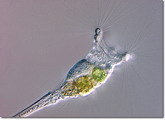Populations of rotifers can vary ; one year a pond may have a great many, the next year almost none. Predators of rotifers include aquatic insects, crustaceans (crayfish, water fleas, copepods), small fish, and amphibians. The phylum Rotifera consists of 3 classes, 120 genera and approximately 2,000 described species. Rotifers are found in aquatic and semi-aquatic habitats, but are predominantly freshwater inhabitants. Rotifers are very important in these systems because of their incredible reproductive rates. Population densities often reach greater than 1,000 individuals per liter. Because of their high feeding and assimilation efficiencies, they play important roles in energy flow and nutrient cycling, accounting for more than 50 % of the zooplankton production in some freshwater systems. Rotifers contribute to both the microbial loop and to higher trophic levels. In addition, species assemblages of rotifers are useful in characterizing lakes in relation to their trophic status.
Rotifers may also be very abundant in the interstitial water of soils reaching densities up to 2 million per square meter. Diagnostic features of rotifers include the ciliated corona ("wheel organ") and the mastax. The corona is located anteriorly and functions in locomotion and food gathering. The corona is modified extensively in some species. The mastax is a muscular pharynx containing a complex set of hard jaws or trophi and is found in all rotifers. These characteristics of these structures have been used extensively in classifying rotifers. Rotifers are small animals, ranging in size from 100 to 2,500 microns. Most species are free-living herbivores, bacteriovores or predators. Rotifers move by swimming or crawling. Some sessile species are permanently attached to freshwater plants. Rotifers display a variety of reproductive modes. Individuals in the class Monogononta generally reproduce by cyclical parthenogenesis.
Females reproduce asexually for the most part, then in response to environmental cues they produce daughters that are capable of producing eggs by meiosis. These haploid eggs develop into males if they are not fertilized. The males produce haploid sperm that can fertilize other haploid eggs. These fertilized diploid embryos are enclosed in several protective layers and are referred to as resting eggs. Resting eggs can be dormant for many years before hatching and developing into parthenogenetic females. Males are degenerate, lacking functional organs other than the testis. In class Bdelloidea, females are thought to have reproduced solely by asexual means for thousands years. Males have never been identified from this class. The seisonids reproduce sexually and the males are fully developed.
Rotifers are a group of microscopic animals that live just about anywhere there is fresh water, including lakes, ponds, streams, puddles, ditches, wet shorelines (especially sand), and even on wet mosses. On this page, we will focus on the Collotheca genus of rotifers. Rotifers have a cylinder-shaped body made of three sections : head, trunk, and foot. The "foot" usually has two "toes" at the bottom. The head of a rotifer has a large, cup-shaped mouth, surrounded by cilia. Cilia are tiny hair-like things which wave back and forth. The rotifer's cilia are used to trap food and to move around through the water. Some rotifer species spend most of their lives swimming around, but most Collotheca rotifers are sessile.
"Sessile" means it attaches to one place and stays there for the rest of its life. The one time Collotheca swims is when it is young and hasn't found its place to attach yet. When the young rotifer is ready, it uses a sticky substance from its foot to attach itself to an aquatic plant. Greater Bladderwort is a favorite plant for Collotheca to attach to. Collotheca are large compared to most rotifers.

 |
 |
 |

